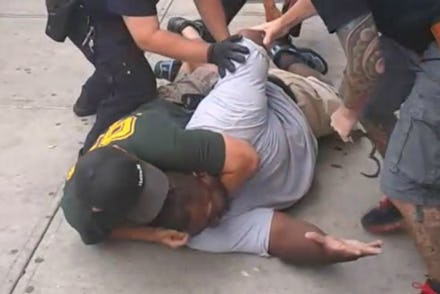What Eric Garner's Death Reveals About America, in 9 Tweets

A grand jury in New York City declined Wednesday to indict a white police officer on criminal charges in the chokehold death of Eric Garner, an unarmed black man, in July. The grand jury's decision came just over one week after a grand jury in Ferguson, Missouri, declined to indict police officer Darren Wilson for the killing of unarmed black teenager Michael Brown.
Jonathan Moore, an attorney for Garner's family, told the Associated Press he was "astonished" there would be no indictment of Officer Daniel Pantaleo in the death of 43-year-old Garner, who was was stopped in Staten Island on suspicion of selling untaxed cigarettes.
Observers across the country responded with shock and outrage on social media, especially since Garner's death had been clearly ruled a homicide by a city medical examiner in July and chokeholds were clearly against New York Police Department policy. But amid anger over the verdict, illustrator and journalist Molly Crabapple perfectly summed up the underlying issue exposed by the Garner verdict.
She's right: After the grand jury decision in Ferguson last week, national attention seemed trained on body cameras as a silver bullet to put an end to the murder of unarmed black men by law enforcement. Michael Brown's parents urged supporters to focus on outfitting police departments with body cameras to ensure that officers could be held accountable for their actions. And on Monday, President Barack Obama called for $75 million to equip 50,000 police officers across the nation with body cameras intended to track their interactions with civilians as part of a three-year, $263 million initiative on police reform that would also expand training for law enforcement.
But that didn't seem to matter in the case of Garner. The Associated Press notes that amateur video shot by an onlooker showed Garner refusing to be handcuffed, to which Pantaleo responding by putting Garner in a chokehold. Garner was 6 feet 3 inches, 350 pounds and asthmatic. His last words, barely audible with an officer's bicep wrapped around his neck, were, "I can't breathe, I can't breathe. I can't breathe." Pantaleo persisted. Garner went into cardiac arrest and died soon afterwards.
Eric Garner had what Michael Brown didn't: a recorded account of his death. And despite the fact that both the NYPD and the New York medical examiner cited clear evidence of wrongdoing, a grand jury refused to hand down justice.
Video simply doesn't matter. While video evidence is generally considered more reliable than witness testimony, it doesn't guarantee that justice. As Tanvi Misra wrote at CityLab, video evidence didn't help the convict Orange County police officers who beat a mentally-ill homeless man to death in 2013. Video evidence didn't help convict the officer who killed Oscar Grant, an unarmed black man in Oakland, in 2009.
Consider Rodney King, who was videotaped being brutally beaten by Los Angeles police in 1991. A jury ended up acquitting three officers in what's considered one of the most widely publicized miscarriages of justice in U.S. history. As Los Angeles Mayor Tom Bradley said following the verdict, "The jury's verdict will not blind us to what we saw on that videotape. The men who beat Rodney King do not deserve to wear the uniform of the LAPD."
And consider Tamir Rice, the Cleveland 12-year-old who police shot and killed for wielding a pellet gun in a public park in November. The rookie officer who shot Rice claims he had "no other choice," but the video clearly shows police firing from their cruiser within two seconds of arriving on the scene.
And this is the problem: "Jury decisions rely on a lot more than just the existence of video footage," notes Misra. "They depend on how that evidence is presented." It also matters how that evidence is interpreted — and this is where race matters. While most folks will tell you otherwise, White America is generally convinced that Black America commits more crimes than it actually does. A 2012 study in the journal Criminology compared the results of two surveys, which asked people in Florida and throughout America how responsible they thought black Americans were for various crimes. In every category, respondents overestimated the percentage of crimes that black Americans committed:
This doesn't mean that every white American is a card-carrying member of the KKK. But fear and anxiety over black lawlessness adds up: According to a recent study in the Journal of Personality and Social Psychology, even when attitudes have only a small impact on actions, individual prejudices can easily turn into racist institutions.
So now what? The NYPD's official Twitter feed, shortly after the verdict, announced that officers will now be equipped with body cameras.
But how, by any stretch of the imagination, can body cameras prevent more Michael Browns, more Eric Garners and more Tamir Rices? They can't. The problem runs far deeper than anything a simple piece of technology can fix. It runs deeper than the police officers who patrol the streets of American neighborhoods. It's a cultural problem, a virus that infects the people who occupy the institutions designed to dispense justice.
Mallory Ortberg, editor of The Toast, sums it up best:
As Vann Newkirk wrote, "The system cannot fail those it was never designed to protect."